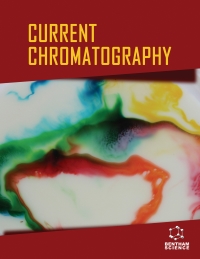- Home
- A-Z Publications
- Current Chromatography
- Issue Home
Current Chromatography - Current Issue
Volume 9, Issue 1, 2022
-
-
Development of Urinary Assay Methods for the Estimation of Paracetamol Glucuronide and Paracetamol Sulphate in Preterm Neonates with Patent Ductus Arteriosus
More LessAuthors: Diab E. Diab and Kannan SridharanAims: This study aimed to develop a high-performance liquid chromatography (HPLC) technique for estimating paracetamol glucuronide and paracetamol sulphate in the urine samples of preterm neonates. Background: Validated methods exist for estimating the principal metabolites of paracetamol in older children and those with liver disease. Here, we have developed and validated a simple technique for estimating the Read More
-
-
-
Development and Validation of an HPLC Analytical Method to Determine 6-Merpactopurine Concentration in Oral Suspension
More LessBackground: The 6-mercaptopurine is an active ingredient used to treat certain types of leukemia. This drug is an immunosuppressive and antineoplastic agent that belongs to the thiopurine class. In Brazil, 6-MP is currently available only in the form of 50 mg tablets, sold as Purinethol® and manufactured by Glaxo Smith Kline. The lack of the liquid formulation’s production impedes treatment, assuming that one of its adv Read More
-
-
-
Simultaneous Determination of Prasugrel and its Process Related Impurities and Degradation Products in Bulk Drug Substances by RPLC-UV
More LessAims: This study aims to determine the quantitative prasugrel (PG) and its all possible process-related impurities. Background: To the best of our knowledge, very few analytical methods are available in the literature for monitoring process related impurities and degradation products of PG in bulk drug substance/ active pharmaceutical ingredient (API). Objective: The objective of this study is the separation of Prasugrel and its Read More
-
-
-
Sensitive UHPLC-MS/MS Technique for Monitoring Levothyroxine (T4) in Human Serum Against Endogenous Thyroxin Level
More LessBackground: Levothyroxine is a synthetic thyroid hormone that is chemically identical to Thyroxine (T4), which is secreted by the follicular cells of the thyroid gland. Levothyroxine is used to treat deficiency of thyroid hormone and prevent the recurrence of thyroid cancer. Levothyroxine is present endogenously in the human body. Methods: It requires a treated matrix for the preparation of calibration curve standard and qu Read More
-
-
-
New, Fast, and Sustainable Method by HPLC for Simultaneous Determination of Ascorbic Acid and Nicotinamide in the Study of Cosmetic Emulsions
More LessAims: This study aimed to develop a new, fast and sustainable method by highperformance liquid chromatography (HPLC) for simultaneous determination of ascorbic acid and nicotinamide in the cosmetic emulsion. Background: Nicotinamide (NIC) and ascorbic acid (AA) are powerful antioxidants. AA presents excellent reducing power and protects the cell from oxidation. NIC is a precursor of NADPH and NADH, substa Read More
-
-
-
A Quantitative Estimation of the Behaviour of Unsaturated Lipid Molecular Species During Their Argentation Liquid Chromatographic Separation
More LessBackground: Analysis of experimental retention data upon several variants of argentation liquid chromatographic separations of different mixtures of the same lipid class into their molecular species was made to estimate new parameters of their π-complexes for every unsaturated fatty acid residue as its silver ion cluster. Methods: Planar reversed-phase liquid chromatography, both in the presence and absence of silver ions Read More
-
-
-
Development and Validation of Stability Indicating RP-HPLC Method for Simultaneous Determination of Doxycycline and Rifampicin in Polymeric Nanoparticles
More LessBy Shilpa DawreBackground: The combination of doxycycline (DOXY) and rifampicin (RIF) is recommended as a treatment therapy for brucellosis by the World Health Organization. Objective: The aim of the current study was to develop and validate the stability-indicating reversephase high-performance liquid chromatography (RP-HPLC) method for the analysis of a combination of doxycycline & rifampicin. Methods: The RP-HPLC method Read More
-
-
-
Impurities Present in Cardiovascular Active Substances and Medicinal Products: A Pharmacopoeial Perspective
More LessAuthors: Arvind K. Sharma, Faraat Ali, Anuj Prakash and Ramesh K. GoyalThe quality of drugs is a major concern for drug regulatory authorities and other stakeholders across the globe. Recently, drug regulatory authorities across the globe are facing a challenge in controlling the purity of cardiovascular (CVS) drugs for human use, especially drugs from the Angiotensin Receptor Blocker family, such as Valsartan. The present article aims to provide comprehensive knowledge on how pharmac Read More
-
-
-
Implementation of Quality by Design Approach for Optimization of RP-HPLC Method for Quantification of Abiraterone Acetate in Solid Dispersion in Forced Degradation Studies
More LessBackground: Abiraterone acetate is a derivative of steroidal progesterone, used as a firstline therapy for metastatic castration of prostate cancer. Objectives: The present study encompasses the design of an experiment approach for developing a simple, reliable, and rapid RP-HPLC method for the estimation of abiraterone acetate. Methods: The chromatographic separation was efficiently conducted on a Hypersil Gold C18 (50 x Read More
-
-
-
HPLC Fingerprint Analysis Coupled with Multivariate Analysis for Quality Assessment of Picrorhiza kurroa Rhizomes
More LessAuthors: Nikunj D. Patel, Rinkal N. Patel, Kunjal L. Vegad and Niranjan S. KanakiBackground: Kutki, the dried rhizome of Picrorhiza kurroa Royle ex Benth belonging to the family of Scrophulariaceae, has been utilized globally for liver ailments. Objective: Comprehensive use of kutki needs to evaluate its role as a quality control tool for discrimination of kutki samples, and therefore an effective HPLC fingerprinting method was established. Methods: Reverse-phase high-performance liquid chromatography w Read More
-
Most Read This Month Most Read RSS feed
Article
content/journals/cchg
Journal
10
5
false
en


